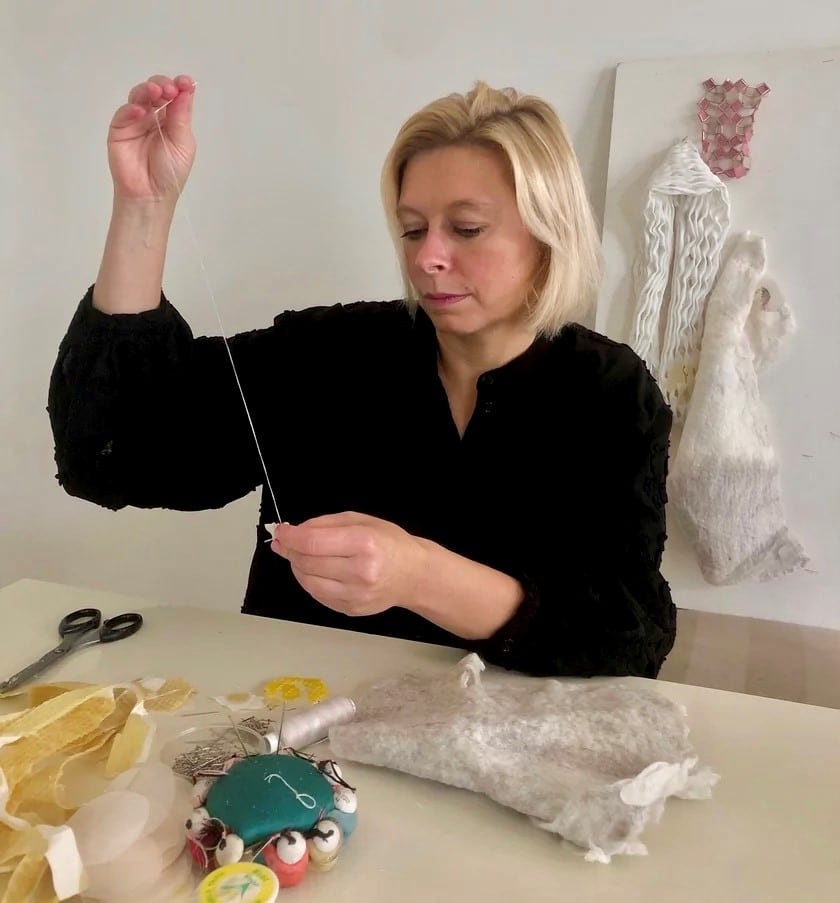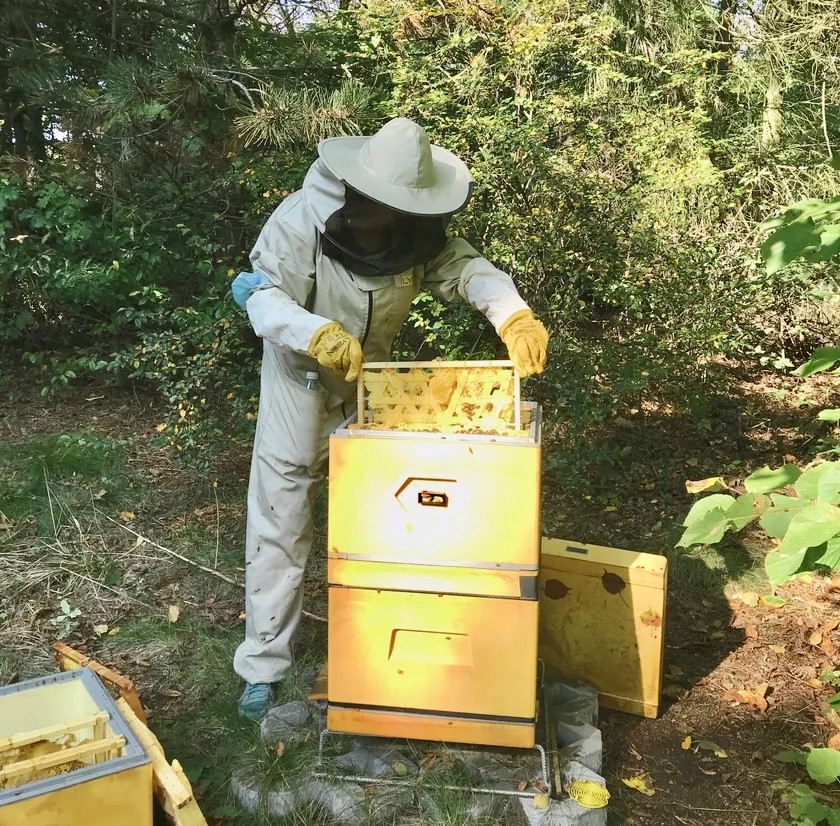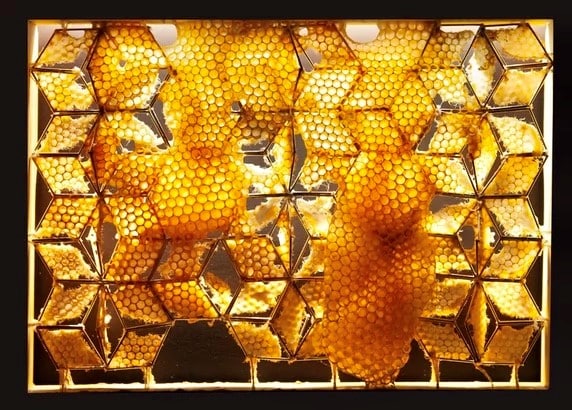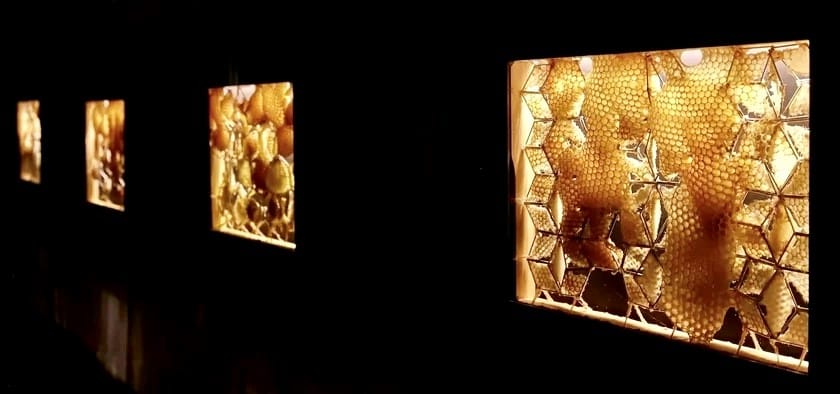The Polish artist who conquers Europe. Magdalena Komar creates extraordinary works together with bees.
During the two years of the pandemic, Magdalena Komar immersed herself in the fascinating world of bees. The result of this endeavour is an extraordinary collective work with input from both herself and the bees.
Unique bas-reliefs describe modern world experiences and highlight the need to build a new relationship between man and nature, ecology, and even feminism and gender.
Magda Komar is a talented artist, and designer, specialising in fabrics and a lecturer of Textile Design at the Department of Fashion at the Academy of Fine Arts in Warsaw. Prominent fashion houses designers have used the unique designs of her fabrics, including brands such as Alexander Wang, Diane von Furstenberg, Escada and Chanel. In 2020, she started a unique artistic project called “The Practices of Coexistence”, which is combined sculpture, installation and research experiment created in cooperation with another species – bees. During the time of the pandemic, Magda first got acquainted with the basics of beekeeping, and then found beekeepers who helped her to get to know and understand the insects better.

A new dimension of female relationships
Albert Einstein argued that humanity would have survived for a maximum of four years if all bees had disappeared from the face of our planet. These little insects have a huge impact on our lives and play a fundamental role for in ecosystem. Honey bees, although they may not be aware of it, are also real artists. Magda works only with female bees, because it is impossible to deal with male drones because they are so lazy. So she jokes that it is a very feminine-feminine relationship.
Magda Komar learned about the extraordinary natural processes of wax formation and the history of traditional techniques drawing from the symbiosis between man and nature. An important part of this collaboration was constant contact with the bees.
The artist peered into their world, engaging the senses – touch, hearing and smell. She even researched mythology, anthropological and philosophical texts about these insects. Finally, she bought a hive and introduced a bee family to it. She described these activities as “the physical process of constructing a new world”.
The hive has become a kind of laboratory for her. She wanted to enter a relationship with bees, assuming the role of an “uneducated researcher” whose task is not to analyze these creatures scientifically, but to have a dialogue without specific expectations. A honey bee is an insect whose benefits are unique. Therefore, it is worth knowing what is in the hive and that each resident has a different task there.
These creatures fascinate not only because of their diligence and how long their species lives, but also because of the fruit of their work: honey and the produced hexagonal forms, which we can also see in the ear of barley, on turtle’s carapace and in the cellulose cells of hornet nests. In the eyes of ancient thinkers, bees forming honeycombs, always composed of hexagonal prisms, were considered the most perfect, by the divine hand of builders.

Fruit of eco-art
No wonder that the artist was fascinated by the life of bees and the products of their painstaking work. It is a unique natural architecture that reflects potential interspecies dialogue – is it possible to reconcile a completely anthropological perspective with a project involving human-bee collaboration – a species that is still a mystery to us?
Magda Komar emphasizes the need to part with the model based on the principle of human-nature struggle, and as the goal of her project, she describes the search for a symbiotic alternative and “going beyond yourself”. As authors of the project, the artist mentions herself and the Bees – writing about them using a capital letter, because although the idea and initiative could have come from human hands, without the bee co-authors, nothing could have been created. The artist designed and created a series of hive frames, built using various techniques – from laser cutting and weaving.. She also made felt fabrics and nuno felt, creating ornamental forms from sewn metal jewelry tubes, pouring beeswax on felt and silk to invite bees to join them. In this way, “The Practices of Coexistence” were created, works that are a story about symbiosis, human dialogue with other species, with nature, of which we ourselves are a part.

Bees have become sculptors while struggling with everyday life – reproduction and efforts to ensure the well-being of their offspring. Now, looking at it from a distance, I would say that it was an exchange between us women – artists, mothers, feeders, gatherers, waxers, warehouse workers, fans, females. It was a very feminine relationship. In the world of bees, as in the world of women, responsibility and care for others are involved in their work – artistic activities – says Komar.
Magdalena Komar is a graduate of the oldest fashion school in the world – Paris ESMOD, which she graduated with a special award from Michèle Lemaire. Founded in 1841 by Alexis Lavigne, the personal tailor of Empress Eugenia, wife of Napoleon III, who invented the tailor’s tape measure and was the first to use wooden mannequins. After studying in Paris in 1997–2000, she worked as a costume designer in film,television and theater. She also studied at the Multi Media Textiles department at Loughborough College of Art and Design, and started her own business. She began with luxurious scarves and foulards that were sold in Paris and London under the “MAGALENA” brand.
Since 2005, Komar has been creating modern embroideries, applications and patterns for materials for prêt-à-porter and haute couture collections. Her projects are commissioned by, among others Chanel, Fendi, Donna Karan, Alexander Wang, Zac Posen, Diane von Furstenberg, Kenneth Cole, J. Crew, Isa Seta, Kate Spade, Calvin Klein Home, Banana Republic, and Victoria’s Secret. Since 2010, she has been running Textile Design Studio at the Department of Fashion at the Academy of Fine Arts in Warsaw.

